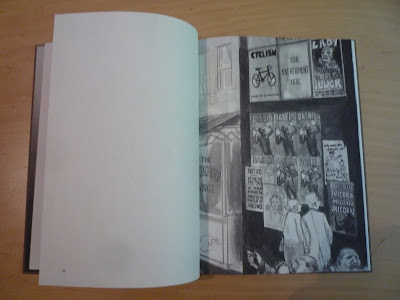You know an exhibition is going to be out of the ordinary when, on entry, you're greeted by a disclaimer: "Please be warned - you enter at your own risk". There's been a lot of buzz surrounding
Site Gallery's newest exhibition 'LIES Inc.', a retrospective of the work of
Eva and Franco Mattes (its been touted in
The Guardian and
BBC). These are notoriously playful artists - 'pranksters' the BBC calls them who in
The Guardian's words will be up to "some kind of no good". Controversy and intrigue are words that come to mind. Afterall, the two are known for stealing, with the help of distraction and a Swiss army knife, fragments from famous artworks by the likes of Warhol, Kadinsky, and Beuys.
The Sheffield exhibition opens with the pair's signature
Catt, a sculpture which features a cat in a birdcage that Eva and Franco Mattes duped the art world with by passing it off as a work by Maurizio Cattelan. The most facinating piece exhibited in Site Gallery was, for me, a work called
No Fun.
No Fun exploits a live-webcam software tool called Chatroulette in which users 'gamble' by accessing and communicating with other Chatroulette users at random. When the unwitting participants click 'Next' and reach the live-feed from the camera Eva and Franco Mattes have set up, the image which greets them is that of an uncomfortably real-looking (but of course, staged) suicide. In
No Fun, we can see both live feeds, the fake suicide and the different user's reactions.
I was mesmerised by
No Fun, watching and listening to the other user's reactions for some time. The experience is really unsettling, not least because it exposes the immoral side to human nature (In the time I watched it, only 1 person called 911; some didn't take it seriously but most of those who did quickly disconnected, keen to alleviate themselves from the situation and any form of moral responsibility).
The other thing at 'LIES Inc.' that really got me was a new work,
Plan C and the ominously named
The Liquidator, described by site as a "sculptural merry-go-round". At the end of the Gallery exhbition, we saw a short film called
Let Them Believe which documents the development of
Plan C. In doing so, it depicts the creation of
Plan C as an undercover research trip to Chernobyl, torn and shattered as it is by the 1986 nuclear disaster. According to the film, the merry-go-round was part of an amusement park being built, and was opened early so that it could be enjoyed before the world seemingly ended.
Plan C itself was the recovery of a merry-go-round from the site, housed for a few short days at a secret Sheffield location as
The Liquidator, the merry-go-round now regenerated or at least cobbled together from materials taken from the Chernobyl site
25 years on. And the materials themselves still hold/emit low-level radioactive charge.
To go on the merry-go-round, we had to sign a disclaimer (!) and were asked to wear Hazmat suits for protection from the radiation. Below you can see Alice, Sarah, Rob, and I all kitted up!
The ride itself was actually really fun. Who doesn't like a merry-go-round? And its location in a disused Sheffield factory by the river was beautiful - street art by
Kid Acne and
Emarama.
At the end of the ride, we were measured for radiation, as was the ride, with the count continuing to rise.
Plan C and
The Liquidator are brilliant works of art, and so unnerving. There's something really perverse about enjoying yourself and having fun on a merry-go-round which signifies tragedy. However, with Eva and Franco Mattes' reputation, can they be trusted? Is
The Liquidator really what it claims to be? Or is it another elaborate hoax, with the
Let Them Believe film serving to authenticate it? Whichever it is (and I think walking the line between the two is in itself fascinating), it works to expose to us the triviality of artfans contemplating how such a work of art made them feel in the context of the horror and tragedy of Chernobyl, itself with timely parallels to recent events in Japan.
Despite, or perhaps fundamental to, the duplicitous nature of their art, Eva and Franco Mattes certainly have a serious message, and one that asks us to confront who and what we are.
(Pictures come from my iPhone and the kindness of Alison Geldart who has a very interesting blog about words
here)





















































